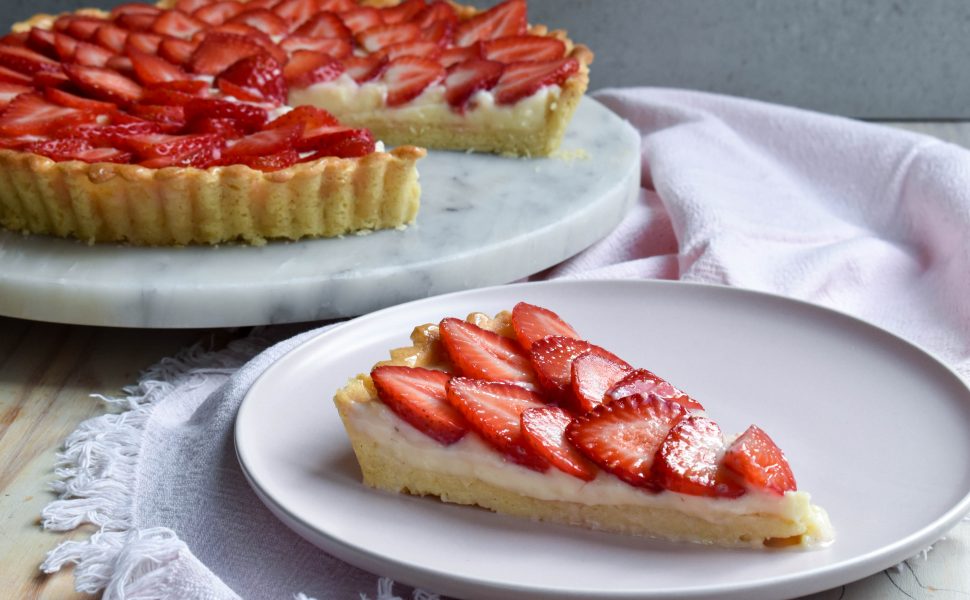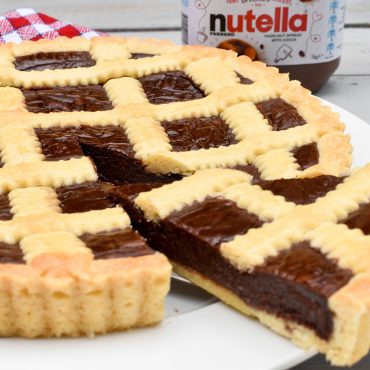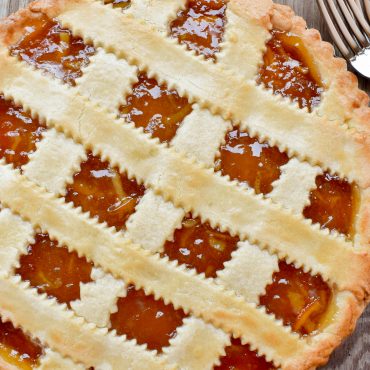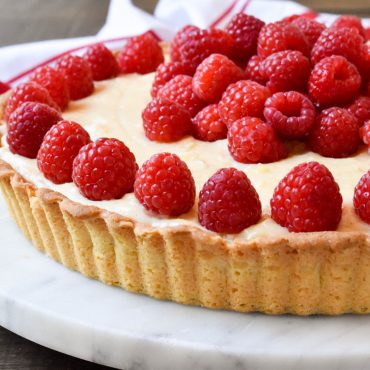Strawberry custard tart
- 350g strawberries, washed, thinly sliced
- 2 tablespoons apricot jam (optional)
- 1 tablespoon of boiling water
- 140g unsalted butter (cold from the fridge if using food processor – see tip in step 1)
- 280g 00 flour (alternatively, use plain/all-purpose flour) – refer to note in step 1
- 100g castor sugar
- 1 whole egg + 1 egg yolk
- Zest of 1 lemon (half reserved for the Crema Pasticciera)
- 1 teaspoon baking powder
- 1 pinch salt
- 4 egg yolks
- 125g caster sugar
- 50g plain (all-purpose) flour
- 500ml milk
- 1 vanilla bean, split lenthways and seeds removed (alternatively 1 teaspoon of vanilla bean paste)
Requires: 25cm round, loose-bottom metal tart tin, rolling pin, whisk, baking beads (alternatively, use rice or dried beans)
In a food processor (with the metal blade inserted): Process the butter, flour, castor sugar and salt until the texture resembles fine breadcrumbs. Add the eggs and baking powder. Add half of the lemon zest, reserving the remaining zest for the custard. Mix until the dough just starts to come together.
Alternatively, by hand: Combine the flour, butter and salt in a bowl. Use your fingertips to rub the butter into the flour until the texture resembles fine breadcrumbs. Add the castor sugar, eggs and baking powder. Add half of the lemon zest, reserving the remaining zest for the custard. Mix by hand until the dough just starts to come together.
Note: 00 is a powder-fine Italian type of flour. It is made from soft wheat varieties and is frequently used in Italian desserts and pastas. 00 flour is available in most supermarkets, Italian food stores and gourmet delicatessens.
Tip: If mixing by hand, remove the butter 20 minutes beforehand to soften slightly.
Turn the pastry onto a clean, lightly floured work surface. Lightly knead to bring together. Gather the dough with your hands to form a ball. Wrap in plastic wrap and refrigerate for 30 minutes.
Meanwhile to make the Crema Pasticciera (Italian custard) for the tart filling, use an electric mixer or hand beater to mix the egg yolks and sugar in a stainless-steel bowl for 5 minutes or until creamy and well combined. Add the flour and a few tablespoons of the milk and beat until smooth. Heat the remaining milk, remining lemon zest and vanilla bean seeds (or vanilla bean paste) in a large, heavy-based saucepan over medium heat until just below boiling point, then remove from the heat. Gradually whisk the hot milk into the egg yolk mixture, then return to the same saucepan. Cook over medium heat, whisking continuously until thick (it should be thick enough to coat the back of a spoon). Remove the Crema Pasticciera from the heat and set aside to cool.
Preheat the oven to 180°C conventional oven (356° Fahrenheit/Gas 4).
Tip: It is not ideal to use fan-forced oven setting for this recipe as the tart shell will brown too much.
Grease a 25cm round, loose-bottom metal tart tin with butter.
Remove the sweet pastry from the fridge. Turn the dough onto a large sheet of non-stick baking paper or well-floured work surface. Use a floured rolling pin to roll out the dough. It should be large enough to fit the base and sides of the tin, allowing a slight overhang. Flour the rolling pin well and gently roll up the sweet pastry dough around the rolling pin. Unroll the sweet pastry dough into the metal tart tin. Trim the edge by running the rolling pin across the top of the tin, then gently push the pastry a little above the edge of the tin.
Tip: Any remaining sweet pastry can be baked as biscuits.
Use a fork to prick the pastry base all over. Refrigerate for 30 minutes to chill.
Remove the tart base from the fridge. Line the tart base with baking paper and fill with baking beads (alternatively, use rice or dried beans). Blind bake for 12 minutes.
Note: Blind baking is the process of baking the pastry with baking paper and baking beads of your choice. The weight of the baking beads stops the sweet pastry crust from puffing up while baking.
Remove baking paper and baking beads (or rice/dried beans if used). Bake for another 12 minutes. Remove from the oven and allow to cool for a minimum of 30 minutes before filling with custard.
To decorate the tart, spoon the Crema Pasticciera into the tart base. Arrange the sliced strawberries over the custard layer, starting with the outer edge and working inwards until the tart is completely covered.
Combine the apricot jam and boiling water in a bowl, then brush the strawberries with the jam mixture (this step is optional).
Tip: The jam creates a shiny finish on the strawberries.
: Refrigerate the Strawberry custard tart until ready to serve – buon appetito!




